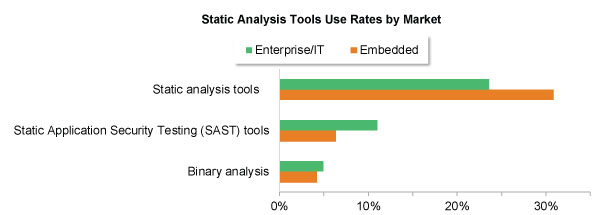| |
FOR IMMEDIATE RELEASE
Contact:
Eugene Won
Senior Director of Marketing & Client Services
VDC Research
(508) 653-9000, ext.122
ewon@vdcresearch.com
Multi-Pronged Test Tool Approach Necessary to Combat Software Vulnerabilities, According to VDC Research
Emerging trends include static analysis, dynamic, and model-based tools
NATICK, MA | May 12, 2017 - Growing recognition that software issues can have profound safety, liability, and brand equity impacts is encouraging the adoption of a multi-pronged test tool approach, according to a new report from VDC Research (click here for more info). More teams are using a multi-tool strategy – combining static analysis, model-based, fuzz, unit, and other types of testing tools - to improve their coding and integration efficiency, and address security concerns.
VDC‘s findings indicate that embedded software engineering and enterprise/IT software development teams are facing mounting challenges as their code bases increase in size and complexity, incorporate more third party code, and must adhere to more process standards. “Developers face rising development costs, more code defects, and the need to use more third-party developed code,” said André Girard, Senior Analyst of IoT and Embedded Technology at VDC. “The IoT is further compounding these challenges: growing connectivity is exposing many systems and embedded devices that were originally designed to operate in isolation. Vendors with integrated test tool offerings that include covering multiple test types will be best positioned for future success.”
 The report explains that software is becoming a central component of brand value. Across the embedded and enterprise markets the importance of efficiently producing high quality code continues to rise as more services, product functionality, and brand equity depend on software. Critical security and functionality concerns are encouraging software teams to “shift-left” and use static analysis test tools more frequently and earlier on in the development lifecycle. VDC suggests this will help to ensure that software code and systems are designed to limit the attack surface, as well as curb project delays and budget overruns due to troubleshooting. Organizations are increasingly applying dynamic test tools to ensure the necessary code coverage has been applied and to validate models and generated code back to the requirements. The report explains that software is becoming a central component of brand value. Across the embedded and enterprise markets the importance of efficiently producing high quality code continues to rise as more services, product functionality, and brand equity depend on software. Critical security and functionality concerns are encouraging software teams to “shift-left” and use static analysis test tools more frequently and earlier on in the development lifecycle. VDC suggests this will help to ensure that software code and systems are designed to limit the attack surface, as well as curb project delays and budget overruns due to troubleshooting. Organizations are increasingly applying dynamic test tools to ensure the necessary code coverage has been applied and to validate models and generated code back to the requirements.
The impact of open-source and very low cost alternatives is increasing and will limit the growth in commercial test tool adoption. “Developing a compelling return on investment argument for automated testing tool expenditures may be especially challenging for smaller organizations with limited development budgets. It is critical for suppliers to demonstrate the differentiation of their offerings, educate the market about the risks from poor test results, and ensure easy set up and operation of their tools to succeed against the low cost competition,” explained Girard.
Click here for more information on this research.
About VDC Research
Founded in 1971, VDC Research provides in-depth insights to technology vendors, end users, and investors across the globe. As a market research and consulting firm, VDC’s coverage of AutoID, enterprise mobility, industrial automation, and IoT and embedded technologies is among the most advanced in the industry, helping our clients make critical decisions with confidence. Offering syndicated reports and custom consultation, our methodologies consistently provide accurate forecasts and unmatched thought leadership for deeply technical markets. Located in Natick, Massachusetts, VDC prides itself on its close personal relationships with clients, delivering an attention to detail and a unique perspective that is second to none.
###
|
|